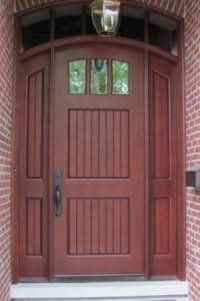If you live in Burr Ridge, IL, weather conditions are extreme when the seasons change, so you should invest in quality doors. Not all doors are the same, and many doors are not energy-efficient. For instance, the door’s material, core, and glass options decide its overall energy efficiency. All the materials work together to reduce heat flow and air leakage indoors.
Different Energy-Efficient Doors
Fiberglass, aluminum, and wood are the most common materials for doors. Other than wood, the different materials contribute to insulation. Again, the door’s material and the insulation inside all play essential roles in energy efficiency.
Fiberglass
Doors that consist of fiberglass are among the strongest on the market. In addition, they also offer some of the most energy efficiency. Since fiberglass is a poor conductor of heat, it’s already energy efficient. However, when insulation is a factor, it is hard to beat. Due to this, it is best to purchase fiberglass entry doors with foam cores.
Aluminum or Steel
Another popular choice for exterior doors is metal. More specifically, aluminum and steel. Aluminum and steel are both excellent thermal insulators. This makes it an energy-efficient option.
On the downside, though, these materials conduct heat. You are likely to be able to feel the outside heat or cold if you touch the door. Aluminum and steel are great for energy efficiency. They are not exactly quite as durable as fiberglass, though. Also, keep in mind that metal is very susceptible to dings and damage.
Wood
Some of the most beautiful and classic doors are wood. They can add curb appeal to your home, thus increasing value. Wood, though, is a poor insulator because it absorbs heat more quickly than other materials. These kinds of doors also contribute to heat flow, allowing outside temperatures into the home.

Our doors have best-in-class energy efficiency, durability, and security
Other Energy-Efficient Elements
Since the primary material is only part of what makes the door energy-efficient, other areas up for consideration are insulation, frame, glass, and weatherstripping. These aspects factor into the door’s R-value, U-factor, and overall energy efficiency.
- Insulation: Even if the entry doors are fiberglass, the professionals recommend polyurethane foam insulation. This material has a high thermal resistance and relatively high R-value. For these reasons, it is effective on the market.
- Frames: The frame is almost as important as the door itself. Remember that metal door frames are poor insulators and susceptible to damage. Wood frames are average with insulating and have their problems. Rot, termites, and other pests are just a few.
- Energy-efficient glass: It is essential to pay attention to glass inserts with fiberglass doors because not installing them can decrease energy efficiency. Look out for double or triple-paned glass.
- Weatherstripping: This part of the door runs along the frame’s top, bottom, and sides. It acts as a proper seal against the elements. There are plenty of options for weatherstripping, while the efficacy depends on the material, installation, and flooring your door opens over.
Call Opal Exteriors for an Estimate Today
If you want to replace the entry door to your Burr Ridge, IL home, turn to Opal Exteriors. Call our office to schedule an appointment for an estimate, or complete our contact form today.



